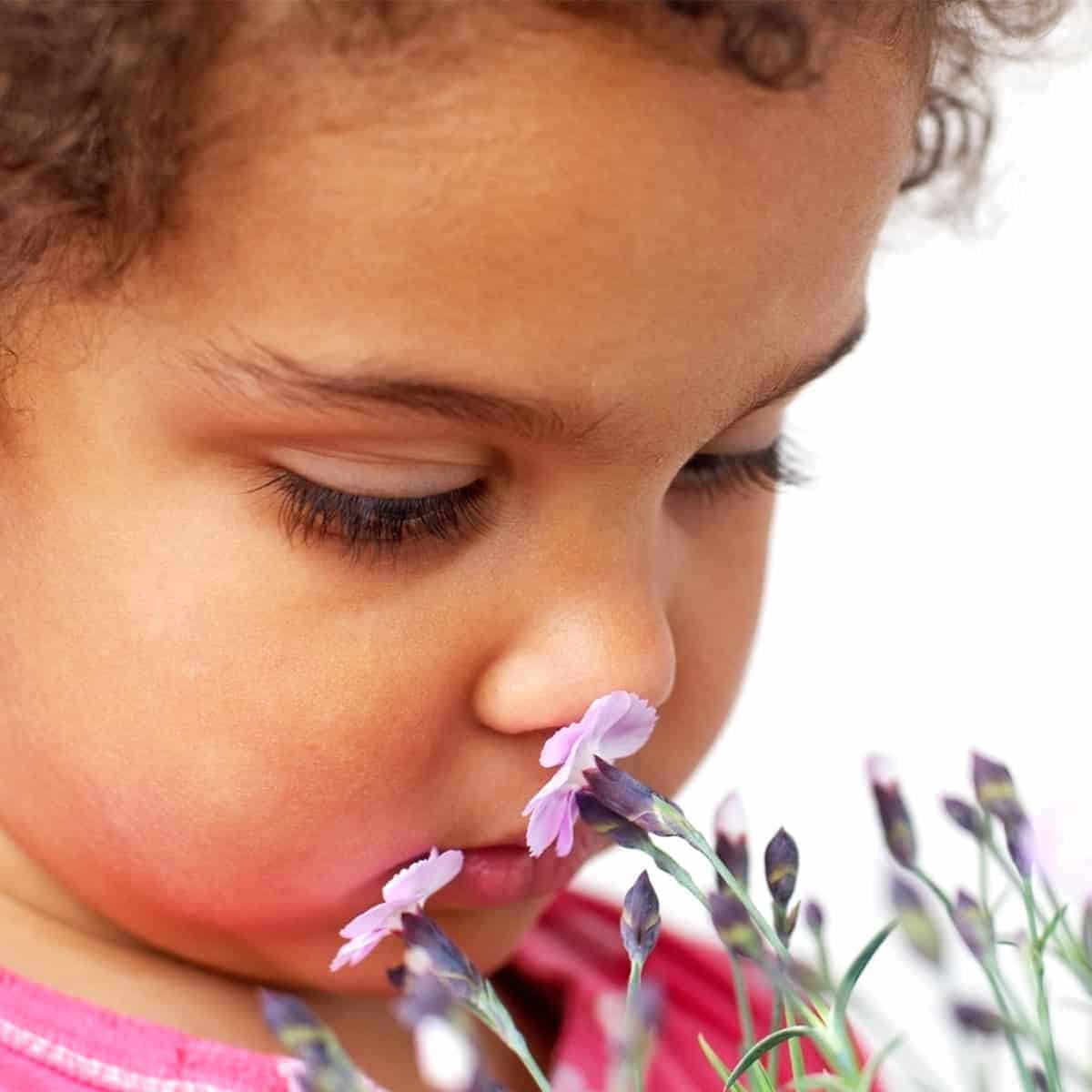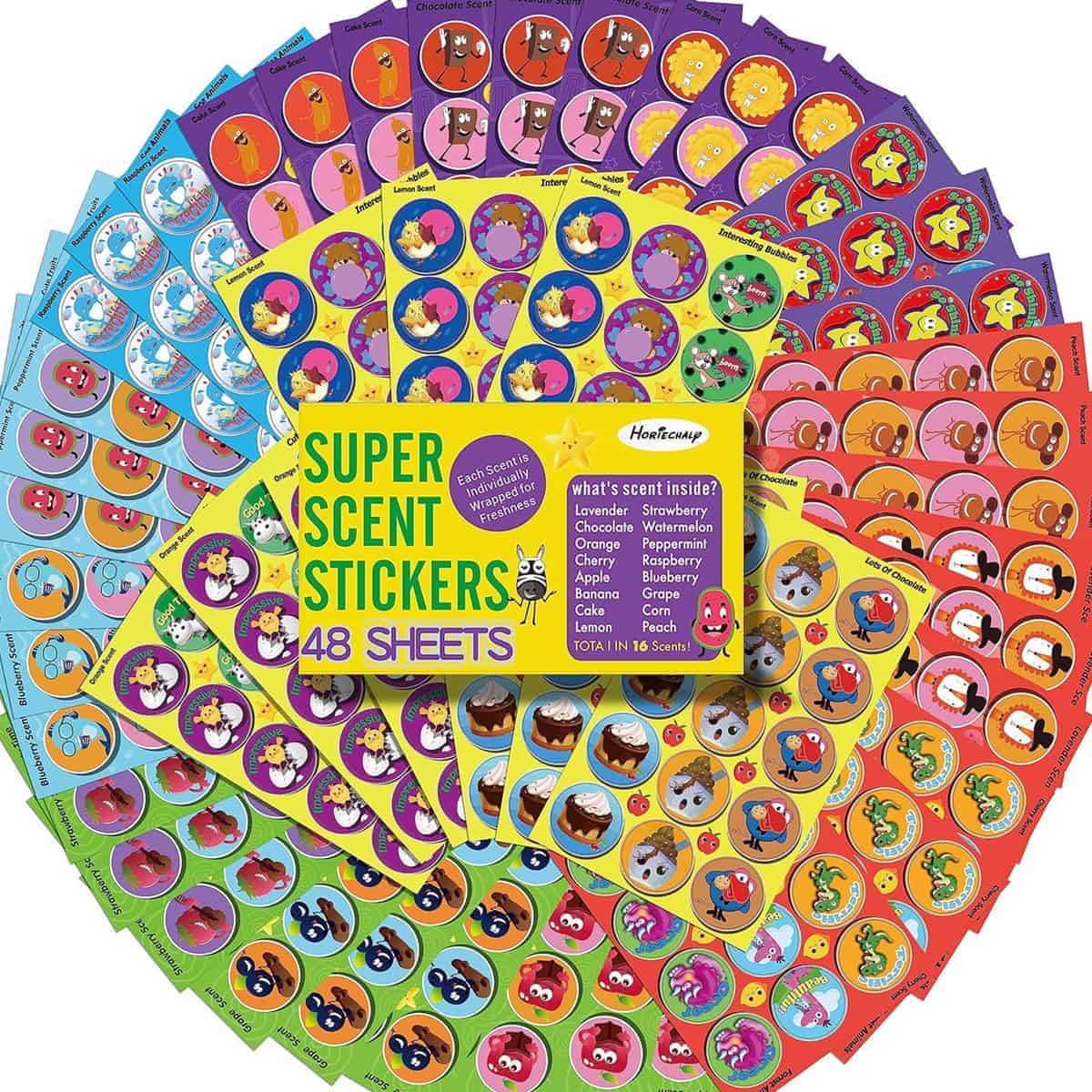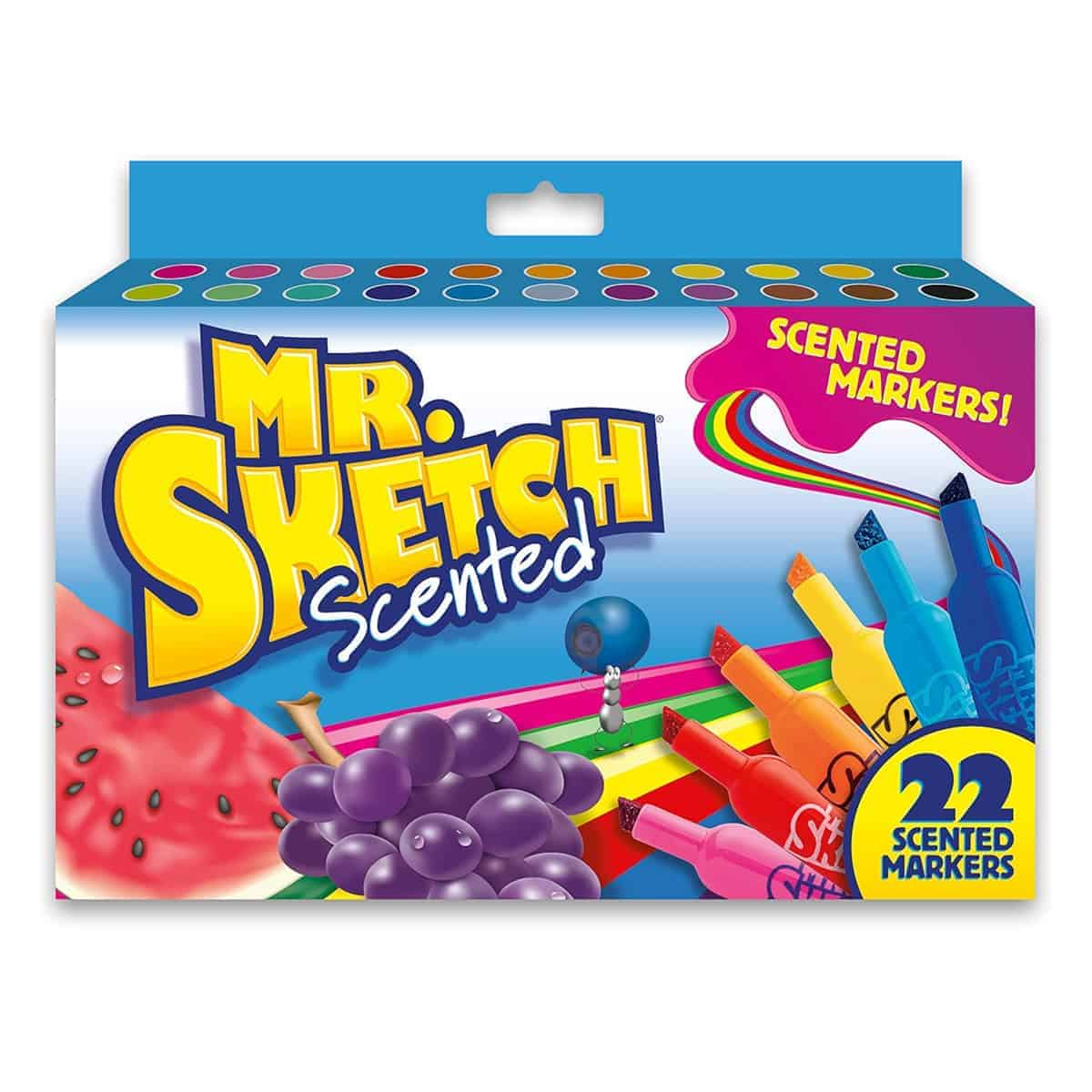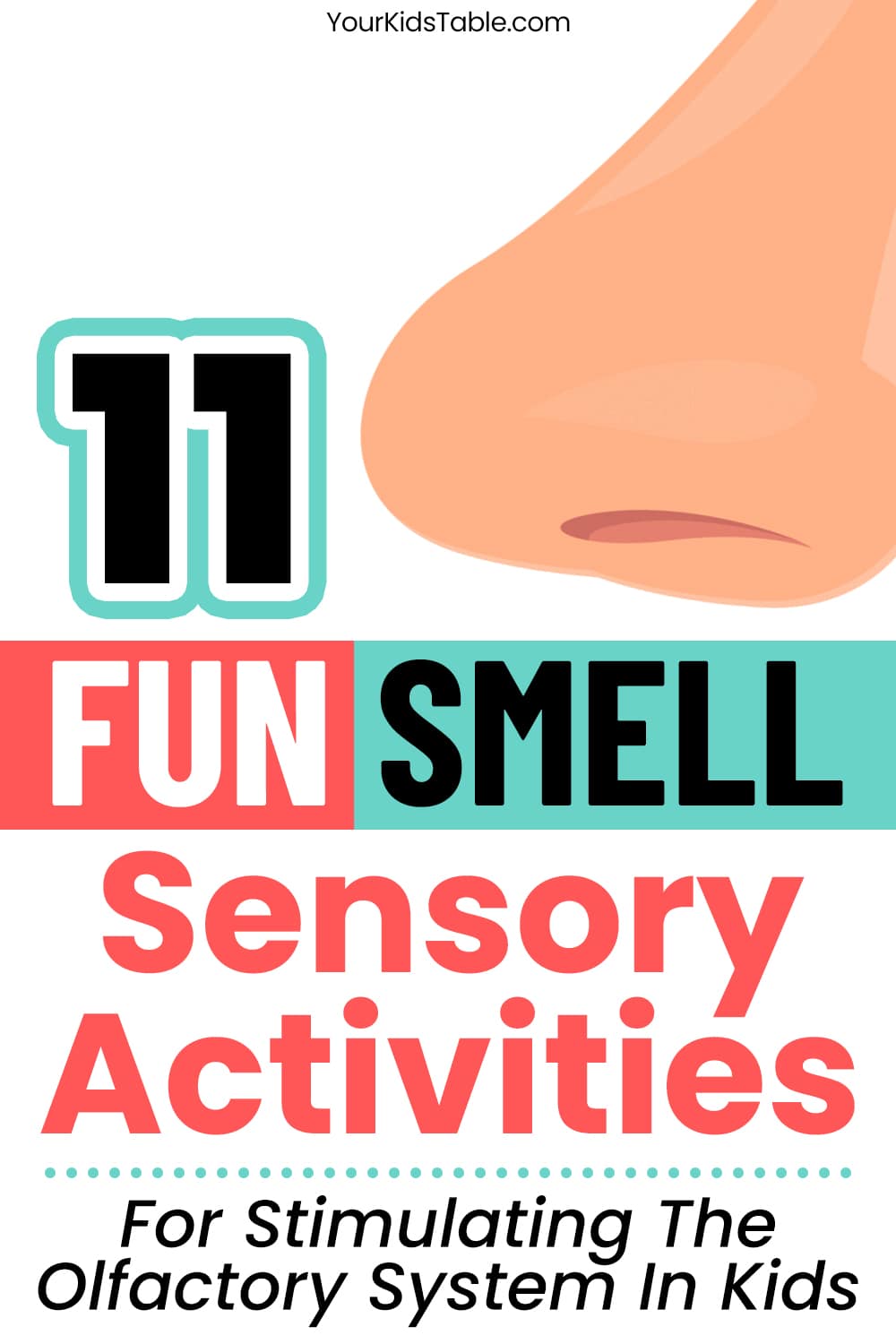Get 11 easy smell sensory activities, and learn how to help kids with smell sensitivities! Perfect for preschoolers, kindergartners, and kids with sensory issues/SPD.
This post contains affiliate links. See our full disclosure.
In Boulder, Colorado is the Celestial Seasonings Tea factory where you can take a tour to see how they process and package all of their assortment of teas.
It might sound boring (unless you’re a tea enthusiast like me!) but it is an incredible tour experience.
At one of the stops on the tour, you enter the “mint room” where they process fresh mint leaves into some of their signature tea blends.
The intense sensory experience of smelling thousands of pounds of mint being cut and dried into tea bags is hard to describe. I can’t smell mint now without thinking about that room.
I’m sure you have a scent memory like this.
Maybe the aroma of fresh cut grass floods your mind with excitement of hot summer nights, baseball games, and days spent at the pool?
The body’s sense of smell, also known as the olfactory system, is one of our 8 sensory processing senses that all make up our body’s ability to interact with and process the world around us.
Sensory processing is responsible for so much of our day to day lives, and our sense of smell is no different!
And while smells like fresh baked cookies and warm campfires bring us comfort and nostalgia, some sensory kids deal with the negative side of olfactory processing, which makes them uncomfortable and downright miserable around certain smells.
This can affect day to day independence, eating, and more.
Before we dive in, let’s talk a little bit about how our sense of smell works.
How Our Sense of Smell and The Olfactory System Work
In order to smell something, there is a lot of sensory processing and communication that goes on between our brain and our body.
When we breathe in, small hairs in our nose react to odor molecules in the air, trapping the molecules in order to dissolve them into the mucus lining of our nose and throat.
This area is full of tiny receptors which then send a signal to our brain through something called the olfactory bulb of the olfactory nerve.
These electrical impulses are then interpreted by the brain as different smells.
These receptors that process smell are called chemoreceptors, which are the same type of chemical receptors that we use for taste. Remember how I talked about how smell can affect eating? This is why scent and taste go hand in hand!

Disorders of the Smell Sense
There are a few common disorders of the sense of smell. These include:
- Anosmia: A complete loss of the sense of smell
- Hyposmia: A reduced ability to smell
- Parosmia: A change in the normal perception of odors (when something that normally smells pleasant now smells bad)
- Phantosmia: The sensation of an odor that is not present
Things like illness (like having a stuffy nose), physical issues (like enlarged tonsils, obstructed respiratory airways like a deviated septum) and sensory processing issues, can all cause or make some of these smell disorders worse.
Sensory Processing Disorder: Olfactory Avoiding Signs
Many kids’ brains over process sensory information, meaning they seem to be more sensitive to the input they’re getting from the world around them.
Body odor, perfumes and detergents, and the smell of what you happen to be cooking for dinner can overwhelm their brain into a really uncomfortable experience.
Even putting a child into a dysregulated state that leaves them agitated. They’re likely to respond with flight or fight behaviors which leave us frustrated and confused.
It can be hard for adults that don’t have smell sensitivities to relate to. To get a glimpse of what your child may be going through imagine something you absolutely can’t stand the smell of…
Sauerkraut, a dirty diaper, or sports equipment that’s been left in a gym bag too long?
The intensity of those smells for you, is often what everyday smells are like for a child with a smell sensitivity.
This is indicative of sensory avoidance, and is due to sensory processing.
Some kids with smell sensitivities may have Sensory Processing Disorder (SPD) or Autism Spectrum Disorder (ASD), although smell sensitivities occur in kids without these diagnoses too. For a child who is over processing their sense of smell, you may notice the following difficulties or signs related to their smell sensory processing:
- Complaining that things constantly smell bad
- Being sensitive to smells (avoidance, headaches, etc.) even when they seem mild to the average person
- Picky eating, claiming foods are “too spicy” or “strong flavored”
- Refusal to complete daily activities such as bathing or using soaps/shampoo/toothpaste due to smell and taste sensitivities
- Gagging or even throwing up around a new food or different smells
- Becoming overwhelmed in crowds or close contact around groups due to increased smells, even avoiding certain houses because of how they smell
- Fear of public bathrooms
Sensory Processing Disorder: Olfactory Seeking Signs
For other children, they will be on the opposite side of sensory processing and their brain will under-process the smell sensations. Any of the following signs may indicate smell seeking:
- Actively smells everything around them, often exploring their environment but smelling everything around them, including people. They will often take long deep breaths in through their nose to get as much of the odor as possible.
- Loves any strong smells such as essential oils, perfumes, and/or scented lotions and seeks out smelling them often
- Attraction to unpleasant odors such as feces, and will touch, smell, and even taste it
- Interest in dangerous fumes such as gasoline, bleach, cleaning products
Sensory Processing Disorder: Olfactory Low Registration
Lastly, some kids don’t seem to register smell at all, which is another type of difficulty with sensory processing. Some signs of smell low registration are:
- Doesn’t seem to notice smells at all
- Barely, not at all, notices very strong smells that bother other people in the same environment
- Seems unaware of strong flavors or smells from food, which may cause picky eating or intense flavors/smells in their food like sour, spicy, or bitter tastes
11 Awesome Sense of Smell Activities
Sensory activities are some of the best ways to work on building strong sensory processing skills with kids.
These activities are powerful for young children and those of all ages and developmental abilities because they are fun and your child won’t even know there is an important purpose behind the sensory activity that they’re doing. But they work!
The key is being consistent and trying these activities in different ways to build up interest and tolerance to the sensory input you’re working on. Never force your child, but also don’t be defeated if your child is hesitant or flat out refuses at first.
If you have a child that is very sensitive to smell, break these activities down into small steps and see the next section for additional ways to support smell avoidance.
As with all activities, supervise your children while completing these, and use your discretion for safety depending on their abilities and independence levels, especially situations where they might put items in their mouth.
Smell Activity 1: Scented Playdough and Fragrant Sensory Bins
There is no “right way” to do this one, but you can (and should!) get creative. Try adding a drop or two of a preferred essential oil to a homemade or store bought playdough. Or, try making a variety of doughs with different scents to mix and play with.
Stimulating, but generally accepted scents include lemon, mint, lavender, and vanilla extract.
Sensory bins are an incredible way to work on sensory processing too. While they primarily target the tactile sense, sensory bins can also improve picky eating and sense of smell processing.
Try some of these fun ideas for easy and olfactory stimulating sensory bins fillers:
- Hot chocolate mix
- Crushed peppermint, lemon, orange, or other flavored candies
- Essential oils mixed into sand
- Grated citrus zest
- Grass clippings
- Dry tea bag contents
- Grated or shaved bars of soap
- Solid potpourri or scented epsom salts
- Crushed or whole dry cereals (chocolate, cinnamon, etc.)
- Pine needles
Smell Activity 2: Guess the Food or Drink
This is a fun activity that highlights the important connection between our sense of smell and our sense of taste.
It is shocking how similar things can taste when you take away sight and our sense of smell.
Pick items with similar textures but different flavors such as: raw potato vs. raw apple, chips of different flavors, yogurt vs. sour cream, etc.
Blindfold your child, or have them close their eyes and plug their nose. Give them a small bite of one food and have them guess which of the foods they are tasting.
You can try this with paper cups and straws with different liquids as well. This activity obviously depends on a child eating a variety of foods, but even for picky eaters, the novelty of this game can intrigue them enough to possibly try something new.
This is a really fun activity for older kids or for a group of kids to play together and see how they do guessing against each other.
Smell Activity 3: Play With Scratch and Sniff Stickers

Smell Activity 4: Mystery Smell Bags or Smell Bottles
Place between 4-8 items in brown paper bags or empty bottles. Include items like dried leaves, grass clippings, a bar of soap, a slice of lemon, a clean item of laundry, etc.
Either blind folded or with eyes closed, have the child smell each bag and guess what item is inside.
You could also do this with a cotton ball dipped in different essential oils.
Again, this is a great game for kids to play with a group. To make this harder, keep the bags or bottles closed, and try to smell through a small hole or holes in the bag.
Smell Activity 5: What’s the Memory?
This is a fun one that ties in scents with memory and nostalgia. Instead of an organized activity, this is more of a question game to play with your child.
When presented with a specific and unique scent, ask your child, “What does this remind you of?”
You may be surprised to hear their answers. Maybe hot chocolate in a mug reminds them of Christmas. Or baking chicken nuggets reminds them of their favorite play place at Chic-Fil-a.
Asking your child what scents remind them of is a great way to tie in some cognitive processing with language skills, and see what types of things they pay attention to.
This is a good exercise to work on with sensory avoidant kiddos. Maybe a harsh soap reminds them of a doctor’s office where they had a recent bad experience. Knowing this information can help you get insight into what might be bothering them when they melt down over taking a bath.
Smell Activity 6: Color With Scented Markers or Crayons

Smell Activity 7: Involve Your Child in Cooking with a Variety of Flavors and Smells
This may seem simple but I promise it’s effective. It goes along with the strategy of slowly exposing your child to smells over time.
Using fragrant herbs, spices, and a variety of ingredients in cooking not only helps them process smells better, but is proven to help with picky eating. Having your children help you cook has so many benefits.
Smell Activity 8: Spice Painting
Your child can help set this activity up to get even more smell input. Head to the spice cabinet and together gather some ground spices such as cinnamon, clove, ginger, paprika, and cumin.
As you select the spices, ask your child to smell each and describe them.
Then have them help place a teaspoon or so into a small dish and slowly mix with a few teaspoons of water.
This is a good time to have them smell again and see if the smell is as big, or if it’s smaller because it’s been diluted.
Then, you use a paintbrush to make pictures with the spice paints you created, continuing to smell and talk about how the spices smell together in the picture.
Smell Activity 9: Match the Scents
Pick a few items that you can put into water by steeping them in warm or cold water.
Ideas include: instant coffee grounds, lemon juice, and orange peel, a bag of tea, a spoon of cinnamon, etc.
Place each item into a small amount of water in cups or plastic containers and stir until dissolved. Make sure you have a list of what you used, or a piece of each item, so you can match.
Either with a blind fold (for older kids) or with vision (for younger), have your child smell each cup of water. Have them match each item with the corresponding cup and see if they guessed correctly.
Smell Activity 10: Grocery Store/ Farmer’s Market Scent Scavenger Hunt
This one is fun and can be customized to just about any grocery store. But consider trying at an outdoor farmer’s market if you have a seasonal one around.
Have your child carry around a small notebook and pencil (if they are of writing age) or walk with them around the store or market.
Search for things that are fragrant and write them down. Options include: fresh baking bread in the bakery department, bouquets of flowers, cantaloupe or other ripe fruits, roasting chilis, coffee bags, etc.
See how many items your child can find and smell.
Smell Activity 11: Make a Simmer Pot
This is a fun activity for a natural air freshener, and can easily be made to fit a holiday theme or in place of a diffuser, room freshener, etc.
Fill a large soup or stock pot with water, apple cider, or tea.
Add in fragrant items to simmer on the stove including: cinnamon sticks, cloves, bay leaves, slices of fresh citrus or other fruits, pine needles, vanilla beans, etc.
The combinations for this are endless and they are a really fun way to experiment with different smells in the kitchen, as well as create an inviting fragrance for groups or holiday parties.
How to Help Children Who Hate Strong Smells
If your child is avoidant in their sense of smell, there are simple strategies to help them better cope with their sensory sensitivities in day to day life.
As an occupational therapist, sensory play and specific sensory activities are some of my favorite suggestions for long term desensitization of any sensory system, and you just got a whole list of ideas above.
But, you will likely still need to address the discomfort and dysregulation a smell sensitivity can cause right in the moment. Here are some ways to support your child as you work through the longer process of decreasing smell sensitivities:
1.For mild to moderate cases of smell sensitivity, introducing various scents to your child in small increments can help.
You could help desensitize them to a certain smell, or strong fragrances in general. Never force this, but trial scents in calm moments to see how your child responds.
2. Teach your child how to mouth breath, when there is a strong smell in the environment. To do that focus on bringing air in through the mouth instead of deep breaths through the nose
3. Wear essential oils or other preferred and calming scents to overpower any unpleasant one’s they may encounter. For example, if your child is visiting a zoo, they may anticipate some bad smells at the monkey exhibit. Swiping drops of essential oils on their wrist, or using a diffuser bracelet like this can really help.
4. Use scent free detergents, soaps, shampoos, etc. during self help tasks like bathing, washing clothing, and brushing teeth.
5. Teach your child to hold nose or wear a “buff” or bandana to prevent deep breathing of unpleasant smells.
6. Open windows and use fans for ventilation, especially in areas like bathrooms, kitchens, and other areas of the home with strong smell concentrations
7. Work on Improving picky eating because taste and smell are so closely related.
8. Use baking soda in fridges and rooms, light matches, or use oil diffusers to neutralize a scented area
Here are some easy to find, kid-safe essential oils to try.
9. In extreme cases of strong pervasive smells (for example, buying a new home with a history of cigarette smoke or animal smells) use an ozone generator machine to neutralize the air.
10. Regularly try some of the activities in the previous section
Get our Free Sensory Activities Printable!
If your child is having sensory processing difficulties, a “sensory diet” with activities and strategies can really help! Snag our free Sensory Essentials printable to make one for your child, and get a cache of over 25 awesome activities that are incredible for all the senses.
More Activities for the Senses
23 Visual Sensory Activity Ideas for Kids
Powerful Proprioceptive Activities That Calm, Focus & Alert
45 Essential Vestibular Activities and Input Ideas
Everything Oral Sensory Processing: Activities and Input Ideas
Laura Mau is a licensed occupational therapist and member of the Your Kid’s Table team. She has over 8 years of clinical experience in helping families navigate complex feeding and eating, sensory processing, and reaching developmental milestones with their children. She currently practices in Colorado and has 2 young kids of her own.
Alisha Grogan is a licensed occupational therapist and founder of Your Kid’s Table. She has over 19 years experience with expertise in sensory processing and feeding development in babies, toddlers, and children. Alisha also has 3 boys of her own at home. Learn more about her here.
